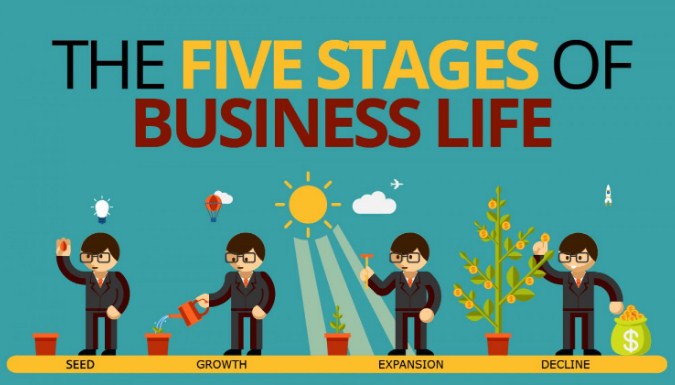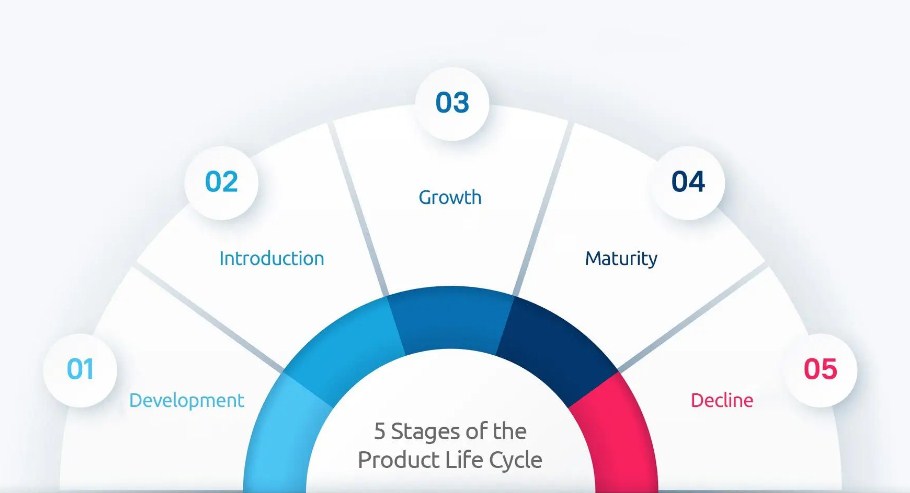5 Stages of the Business Life Cycle – The business life cycle is a critical framework for understanding how businesses grow, evolve, and mature. Whether you’re a startup, a growing enterprise, or an established business, knowing which stage of the business life cycle you’re in can significantly influence your strategic decisions. In this article, we’ll explore the five key stages of the business life cycle, how to leverage them, the best products that can help in each phase, and how to purchase them for optimal results.

What Are the 5 Stages of the Business Life Cycle?
The business life cycle consists of five main stages that businesses typically experience from inception to maturity. Understanding these stages is essential for making informed decisions and ensuring that your business remains sustainable and adaptable.
1. Seed/Startup Stage
This is the birth phase of any business. Entrepreneurs typically come up with a business idea and begin to make initial investments. The main focus at this stage is on market research, product development, and building the foundational structure of the company. Key challenges include funding, customer acquisition, and establishing a brand.
2. Growth Stage
In the growth stage, the business has established its product or service in the market and is now looking to expand. The company increases its market share, and operations scale up. During this phase, businesses focus on refining their offerings and increasing brand awareness. Challenges include managing cash flow, scaling operations, and attracting more customers.
3. Maturity Stage
This stage signifies that the business has achieved stability and growth. The company has an established market presence, a strong customer base, and predictable revenue streams. It now focuses on maintaining market position and maximizing profits. Challenges include maintaining innovation, increasing efficiency, and dealing with competition.
4. Decline Stage
Not all businesses avoid this stage, but it’s a natural part of the life cycle. The business begins to lose market share due to factors such as market saturation, new competition, or outdated technology. Key challenges include managing losses and considering options like pivoting or exiting.
5. Renewal or Exit Stage
The final stage involves either the business finding new growth opportunities (renewal) or closing its doors (exit). Companies may innovate to survive, sell the business, or liquidate assets.
Benefits of Understanding the Business Life Cycle
Understanding the stages of the business life cycle allows entrepreneurs to make better decisions, allocate resources more efficiently, and identify opportunities for growth. Here’s why it’s beneficial to be aware of where your business stands:
- Strategic Planning: Helps tailor your business strategies to the unique needs of each stage.
- Financial Management: Helps identify when to seek funding or when to cut costs.
- Market Positioning: Assists in understanding when to innovate or push for market expansion.
- Efficiency: Allows businesses to optimize operations based on their current needs.
Top Products to Boost Your Business at Every Stage
At each stage of the business life cycle, certain tools and products can help optimize performance and enhance growth. Below are some of the best products to support businesses in each phase.

Product 1: Business Management Software
Best for the Growth Stage
Business management software is essential for businesses looking to streamline operations. Whether you’re managing employees, projects, or finances, business management software can save time and reduce operational errors.
- Use Case: A business owner uses software to track project timelines, communicate with teams, and manage resources more effectively.
- Example: Monday.com
| Feature | Monday.com | Trello | Asana |
|---|---|---|---|
| Project Management | Yes | Yes | Yes |
| Time Tracking | Yes | No | Yes |
| Task Automation | Yes | Yes | Yes |
| Integrations | 50+ integrations | 20+ integrations | 30+ integrations |
| Pricing | Starts at $8/month | Free/Business Plan | Starts at $10/month |
- Pros: Comprehensive tools, great for teams.
- Cons: Can be expensive for small businesses.
Where to Buy: Visit Monday.com to purchase the software directly.
Product 2: Marketing Automation Tools
Best for the Growth Stage
Marketing automation tools help businesses generate leads, nurture customers, and automate repetitive marketing tasks. These tools are especially beneficial in the growth phase when businesses need to scale up marketing efforts.
- Use Case: Automating email campaigns, social media posts, and customer segmentation.
- Example: HubSpot
| Feature | HubSpot | Mailchimp | ActiveCampaign |
|---|---|---|---|
| Email Campaigns | Yes | Yes | Yes |
| Customer Segmentation | Yes | No | Yes |
| Reporting & Analytics | Advanced | Basic | Advanced |
| CRM Integration | Yes | No | Yes |
| Pricing | Free/Paid plans | Free/Paid plans | Starts at $15/month |
- Pros: All-in-one tool, integrates well with CRM systems.
- Cons: Can become costly as the business grows.
Where to Buy: Visit HubSpot to get started.
Product 3: Customer Relationship Management (CRM) Systems
Best for the Growth & Maturity Stages
CRM systems help businesses maintain and enhance relationships with customers by providing insights into customer behaviors and preferences.
- Use Case: Tracking customer interactions and improving customer service.
- Example: Salesforce
| Feature | Salesforce | Zoho CRM | Pipedrive |
|---|---|---|---|
| Lead Management | Yes | Yes | Yes |
| Sales Forecasting | Yes | Yes | Yes |
| Mobile App | Yes | Yes | Yes |
| Custom Reports | Yes | Yes | Limited |
| Pricing | Starts at $25/month | Free/Paid plans | Starts at $14.90/month |
- Pros: Highly customizable, integrates with various tools.
- Cons: Complex and expensive for small businesses.
Where to Buy: Visit Salesforce to learn more.
Product 4: Accounting Software
Best for the Maturity Stage
As your business grows, managing finances efficiently becomes critical. Accounting software helps businesses keep track of income, expenses, taxes, and payroll.
- Use Case: Automating tax calculations and payroll.
- Example: QuickBooks
| Feature | QuickBooks | Xero | FreshBooks |
|---|---|---|---|
| Tax Calculation | Yes | Yes | Yes |
| Payroll Management | Yes | Yes | Yes |
| Invoice Generation | Yes | Yes | Yes |
| Multi-currency Support | Yes | Yes | Limited |
| Pricing | Starts at $12/month | Starts at $11/month | Starts at $15/month |
- Pros: Comprehensive accounting, tax filing support.
- Cons: More suitable for medium to large businesses.
Where to Buy: Visit QuickBooks to get started.
Product 5: Business Analytics Tools
Best for the Decline & Renewal Stage
When your business faces challenges, business analytics tools help identify potential solutions and areas for improvement. These tools enable data-driven decisions to renew business strategies.
- Use Case: Monitoring market trends and business performance metrics.
- Example: Google Analytics
| Feature | Google Analytics | Tableau | Power BI |
|---|---|---|---|
| Data Visualization | Yes | Yes | Yes |
| Real-time Tracking | Yes | Yes | Yes |
| Easy to Use | Yes | Moderate | Moderate |
| Integrations | 50+ integrations | 100+ integrations | 30+ integrations |
| Pricing | Free/Paid versions | Starts at $12/user/month | Starts at $9.99/user/month |
- Pros: Free, offers in-depth insights.
- Cons: Requires setup and learning curve.
Where to Buy: Visit Google Analytics to learn more.
Where to Buy and How to Get These Tools
To purchase any of these tools, simply visit their respective websites linked above. Most platforms offer a free trial, so you can test their capabilities before committing to a paid plan. If you decide to buy, look out for discounts or promotional offers to save on costs.
FAQ – Frequently Asked Questions
1. What are the five stages of the business life cycle?
The five stages are the Seed/Startup, Growth, Maturity, Decline, and Renewal or Exit stages. Each represents a different phase in the development of a business.
2. How can I accelerate the growth of my business?
Investing in the right tools like business management software, CRM systems, and marketing automation tools can significantly help accelerate business growth.
3. What is the most critical stage for business survival?
The Growth stage is often seen as the most critical, as it is when businesses need to scale efficiently and manage cash flow.
4. How do I know when my business is in decline?
Signs of business decline may include reduced sales, loss of market share, or increased competition with no clear differentiation.
5. Where can I buy the tools discussed in this article?
You can purchase these tools directly from their official websites. Links to each product are provided in the article.
This comprehensive guide should help you better understand the stages of the business life cycle and equip you with the tools needed for success at each stage.
Read More >>>
- Understanding the 7 Stages of the Business Life Cycle: A Complete Guide for Entrepreneurs
- Big Data Architectures: Benefits, Use Cases, and Top Products to Enhance Your Data Strategy